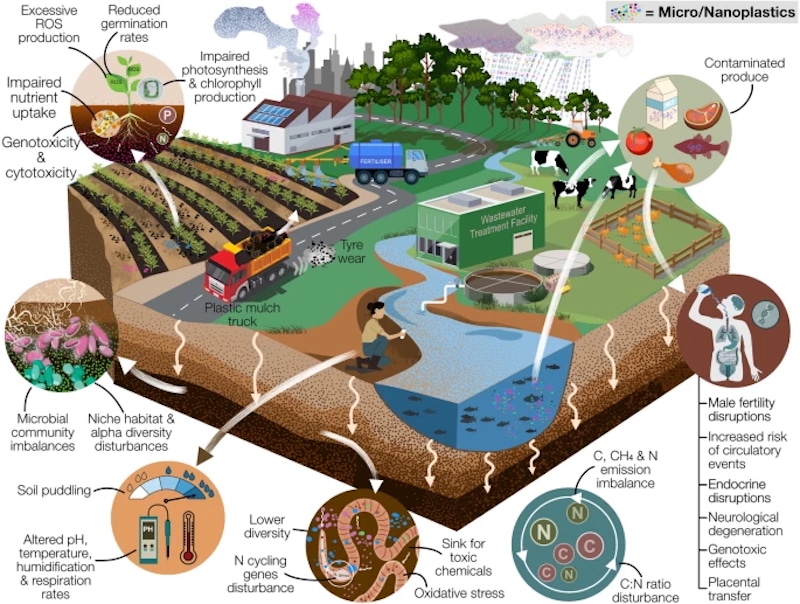This post was originally published on Eco Watch
In a new study, scientists have found that soil used for growing crops can contain up to 23 times more microplastics than the concentration found in oceans.
In the comprehensive study, published in the journal Environmental Sciences Europe, the study authors set out to explore 1) sources of microplastics in soil, 2) how the microplastics and nanoplastics impact soil and crops, 3) microplastic and nanoplastic uptake by crops and 4) how these plastics can carry other pollutants and additives.
The study authors explained that plastic particles can get into the soil from various sources, both on and off the farm. Runoff and atmospheric pollution can contribute, while everything from mulch film and silage wrapping to farm equipment, pesticide containers and sewage sludge fertilizer can also shed microplastics and nanoplastics onto agricultural land.
In particular, plastic mulch film contributes the most amount of plastics, despite providing short-term yield increases, according to a separate study the authors cited.
“These microplastics are turning food-producing land into a plastic sink,” said Joseph Boctor, lead author of the study and Ph.D. candidate, as reported by Phys.org.
As explained in the study, microplastics and nanoplastics don’t remain in the soil. They can spread to other areas of the environment or be taken up by the crops from their roots as they grow.
Previous studies, also cited in this most recent study, confirmed the presence of microplastics in crops, including apples and pears, in addition to protein sources such as seafood and milk. In turn, the potential for consuming crops grown in microplastic-polluted soil is even more concerning following a 2024 study that found ingested microplastics could move from the gut to other organs, including the brain.
Environmental Sciences Europe (2025). DOI: 10.1186/s12302-025-01104-x
Microplastics and nanoplastics can negatively impact soil and plant health, the study determined. Using data from multiple previous studies, the study authors wrote that plastic pollutants are altering microbial diversity in soil, which can then disrupt nutrient and pH balances and nutrient availability in soil. For plants, these pollutants can disrupt photosynthesis, limit water uptake and increase stress, leading to less nutritious crops.
Even plastics considered less harmful, such as BPA-free materials, could still disrupt carbon and nitrogen ratios in soil or release other toxins into soil, but these materials remain understudied, according to the authors.
“And BPA-free does not equal risk-free,” Boctor said. “Replacement chemicals like BPF and BPS show comparable or greater endocrine-disrupting activity.”
As Earth.com reported, these alternatives to BPA have already been detected in some crops, including wheat, lettuce and carrots. The study authors noted that policies and scientific data around BPA and its alternatives range widely by country, and definitions of safe limits vary for soil versus other materials, like food and water.
Notably, the scientists raised concerns over increasing use of plastic additives and lack of studies and regulations around them, particularly because they found that soil microplastics could be exposed to 10,000 chemical additives that are currently unregulated in agriculture.
“This makes the plastic crisis unchecked, and human health exposed,” Boctor said. “This review tries to bring this creeping danger under the radar and shine a flashlight on regulators.”
While the study authors are calling for more research and regulations on plastics and their additives, they are also already getting to work on alternative options in the meantime.
Boctor, along with fellow scientists at the Bioplastics Innovation Hub — a collaboration between Murdoch University and Australia’s Commonwealth Scientific and Industrial Research Organisation (CSIRO) — are working on a Smart Sprays Project. The project goal is to develop a non-toxic, water-retaining barrier that could replace microplastic-shedding practices, such as plastic mulching.
The post Agricultural Soil Can Contain Microplastics at 23x Higher Concentrations Than What Oceans Hold, Study Says appeared first on EcoWatch.





0 Comments